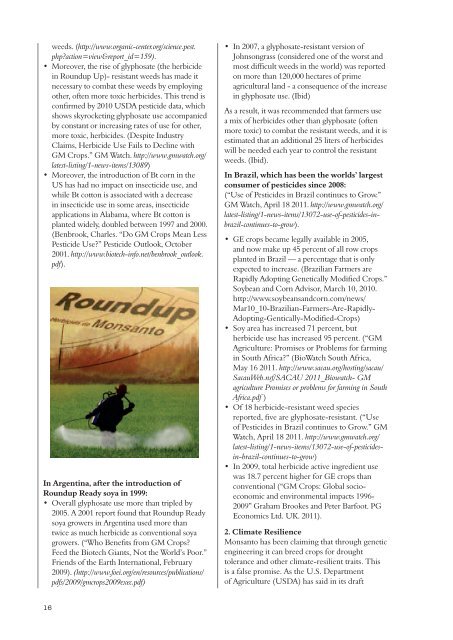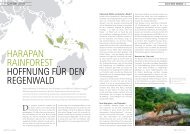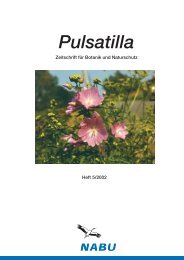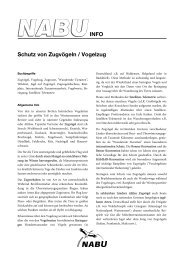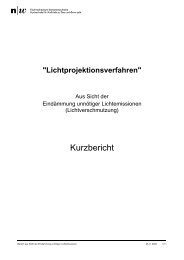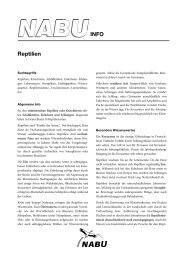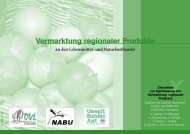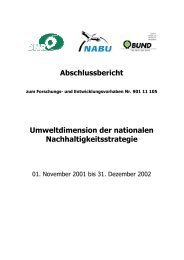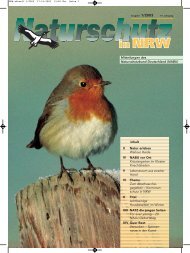Studie "The GMO-emperor has no clothes" (engl.) - Nabu
Studie "The GMO-emperor has no clothes" (engl.) - Nabu
Studie "The GMO-emperor has no clothes" (engl.) - Nabu
Create successful ePaper yourself
Turn your PDF publications into a flip-book with our unique Google optimized e-Paper software.
weeds. (http://www.organic-center.org/science.pest.<br />
php?action=view&report_id=159).<br />
Moreover, the rise of glyphosate (the herbicide<br />
in Roundup Up)- resistant weeds <strong>has</strong> made it<br />
necessary to combat these weeds by employing<br />
other, often more toxic herbicides. This trend is<br />
confirmed by 2010 USDA pesticide data, which<br />
shows skyrocketing glyphosate use accompanied<br />
by constant or increasing rates of use for other,<br />
more toxic, herbicides. (Despite Industry<br />
Claims, Herbicide Use Fails to Decline with<br />
GM Crops.” GM Watch. http://www.gmwatch.org/<br />
latest-listing/1-news-items/13089)<br />
Moreover, the introduction of Bt corn in the<br />
US <strong>has</strong> had <strong>no</strong> impact on insecticide use, and<br />
while Bt cotton is associated with a decrease<br />
in insecticide use in some areas, insecticide<br />
applications in Alabama, where Bt cotton is<br />
planted widely, doubled between 1997 and 2000.<br />
(Benbrook, Charles. “Do GM Crops Mean Less<br />
Pesticide Use?” Pesticide Outlook, October<br />
2001. http://www.biotech-info.net/benbrook_outlook.<br />
pdf).<br />
In Argentina, after the introduction of<br />
Roundup Ready soya in 1999:<br />
Overall glyphosate use more than tripled by<br />
2005. A 2001 report found that Roundup Ready<br />
soya growers in Argentina used more than<br />
twice as much herbicide as conventional soya<br />
growers. (“Who Benefits from GM Crops?<br />
Feed the Biotech Giants, Not the World’s Poor.”<br />
Friends of the Earth International, February<br />
2009). (http://www.foei.org/en/resources/publications/<br />
pdfs/2009/gmcrops2009exec.pdf)<br />
In 2007, a glyphosate-resistant version of<br />
Johnsongrass (considered one of the worst and<br />
most difficult weeds in the world) was reported<br />
on more than 120,000 hectares of prime<br />
agricultural land - a consequence of the increase<br />
in glyphosate use. (Ibid)<br />
As a result, it was recommended that farmers use<br />
a mix of herbicides other than glyphosate (often<br />
more toxic) to combat the resistant weeds, and it is<br />
estimated that an additional 25 liters of herbicides<br />
will be needed each year to control the resistant<br />
weeds. (Ibid).<br />
In Brazil, which <strong>has</strong> been the worlds’ largest<br />
consumer of pesticides since 2008:<br />
(“Use of Pesticides in Brazil continues to Grow.”<br />
GM Watch, April 18 2011. http://www.gmwatch.org/<br />
latest-listing/1-news-items/13072-use-of-pesticides-inbrazil-continues-to-grow).<br />
GE crops became legally available in 2005,<br />
and <strong>no</strong>w make up 45 percent of all row crops<br />
planted in Brazil — a percentage that is only<br />
expected to increase. (Brazilian Farmers are<br />
Rapidly Adopting Genetically Modified Crops.”<br />
Soybean and Corn Advisor, March 10, 2010.<br />
http://www.soybeansandcorn.com/news/<br />
Mar10_10-Brazilian-Farmers-Are-Rapidly-<br />
Adopting-Gentically-Modified-Crops)<br />
Soy area <strong>has</strong> increased 71 percent, but<br />
herbicide use <strong>has</strong> increased 95 percent. (“GM<br />
Agriculture: Promises or Problems for farming<br />
in South Africa?” (BioWatch South Africa,<br />
May 16 2011. http://www.sacau.org/hosting/sacau/<br />
SacauWeb.nsf/SACAU 2011_Biowatch- GM<br />
agriculture Promises or problems for farming in South<br />
Africa.pdf )<br />
Of 18 herbicide-resistant weed species<br />
reported, five are glyphosate-resistant. (“Use<br />
of Pesticides in Brazil continues to Grow.” GM<br />
Watch, April 18 2011. http://www.gmwatch.org/<br />
latest-listing/1-news-items/13072-use-of-pesticidesin-brazil-continues-to-grow)<br />
In 2009, total herbicide active ingredient use<br />
was 18.7 percent higher for GE crops than<br />
conventional (“GM Crops: Global socioeco<strong>no</strong>mic<br />
and environmental impacts 1996-<br />
2009” Graham Brookes and Peter Barfoot. PG<br />
Eco<strong>no</strong>mics Ltd. UK. 2011).<br />
2. Climate Resilience<br />
Monsanto <strong>has</strong> been claiming that through genetic<br />
engineering it can breed crops for drought<br />
tolerance and other climate-resilient traits. This<br />
is a false promise. As the U.S. Department<br />
of Agriculture (USDA) <strong>has</strong> said in its draft<br />
16


